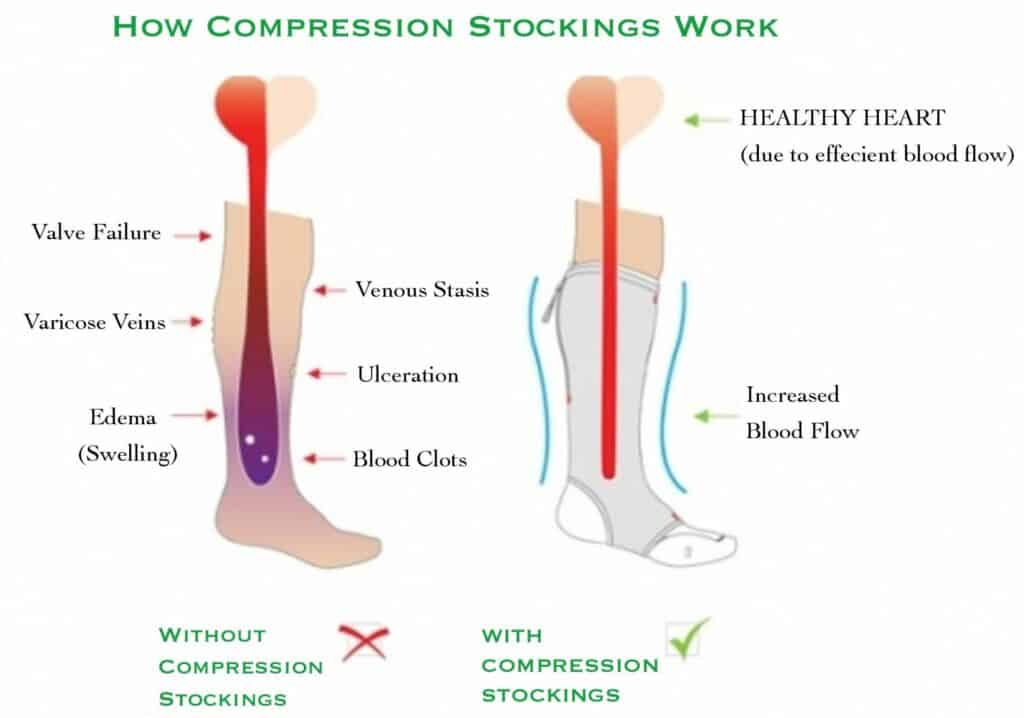Nurses are not only faced with stressful situations in their work. But they are also subjected to many injuries from working on their feet for hours. These are the reasons why nurses wear compression stockings.
Nurses wear compression socks to prevent leg swelling and varicose veins and increase comfort during all-day walking. Walking and standing on your feet for hours badly affects leg health. Compression socks can prevent these problems and improve well-being.
Find out why nurses and other professions where you have to stand on your feet all the time wear compression socks. You’ll also find out some tips on how to prevent sore and swollen feet at work and which compression stockings to buy.
Why do nurses wear compression socks?
Compression stockings are a device that helps nurses do their job more easily. And feel better after long hours of work. These are the three main reasons why it’s a good idea to wear compression stockings if you’re a nurse. Or if you have a job where you stand or sit for hours.

1. They Reduce Swelling
Legs start to swell because of the 12-hour standing on your feet that nurses do most of the time. Water and blood start to accumulate in the legs because of standing for hours. Because we stand for long periods of time, it is harder for the blood to pass to the heart, so it starts to build up in the legs. Compression stockings work by preventing the legs from getting stuck and speeding up blood circulation through the body with their elastic structure.
2. They Reduce the Appearance of Varicose Veins
A multi-hour condition on the leg will cause the appearance of varicose veins. Varicose veins not only don’t look good but can also be painful. They are caused by a build-up of blood in the legs. As a result of the condition, blood clots build up in the veins over several hours, making it difficult for the blood to pass through the body.
Wearing compression stockings can prevent varicose veins from forming. It can also improve your health if you already have varicose veins.
3. They Will Increase Comfort Throughout the Day
Fluid build-up in the body and the formation of varicose veins is uncomfortable for our health and makes it difficult to work. Wearing compression socks during your working day will give you comfort.
Consequences of not wearing compression socks
Doing a job where you stand or sit for hours can have long-term consequences if you do it for years. Here are some of the consequences that can occur:
- In older people, leg swelling becomes more prevalent,
- Shoes become too tight
- Feet appear heavy and tired
- Feet start to ache
This can be prevented by changing the position every 1 hour if possible. If you sit a lot at work, move to a standing position for an hour or at least do something to help speed up the blood flow.

If you are a nurse, you do not have many moments to sit down. You can speed up the blood around your body by doing calf raises or short jumps on your toes as if you were jumping over a jumping rope.
Everything you need to know about Compression socks
Compression socks have a positive impact on your health. When you spend hours in the same position (standing or sitting), blood and fluid start to build up in your legs, making it harder for them to pass on through your body. This causes the various factors we have already mentioned (leg swelling, varicose veins, etc.).

Compression stockings prevent blood and fluid from accumulating in the leg. Due to a special sewing technique, compression stockings push the blood from the bottom up (see picture below).

Due to their elasticity, compression socks fit snugly against the leg to prevent foot jamming. A special stitching technique prevents blood and fluid from accumulating in the legs. This makes you feel better after finishing your job than without compression socks.
After a long time in compression stockings, your feet will no longer be stuck, you will move more easily, and your shoes will not be too tight.
How tight should compression socks be?
Compression stockings have different levels to indicate how tight the compression stocking is. Every seller of compression stockings should specify which level the compression stockings are. There are levels of compression stockings:
- 8-15 mmHg (mild)
- 15-20 mmHg (medium),
- 20-30 mmHg (firm),
- 30-40 mmHg (extra firm) and
- 40-50 mmHg.
The most common are 15-20 mmHg or 20-30 mmHg and are suitable for sports use. Those with a higher compression level are socks prescribed by a doctor for patients who need compression socks due to health problems.
Below are some suggestions of my favorite compression socks.
CopperZen Compression Socks
Fabric Type: 88% Nylon, 12% Copper ions (clinically proven antifungal)
Compression level: 20-30 mmHg
Size: S to XL
You will achieve relief in your feet and prevent the formation of fungi by wearing CopperZen Compression Socks. These compression socks will help you stay on your feet for hours and enjoy your favorite activities again instead of being forced to sit down every 10 minutes.
And with your purchase, you’ll receive 3 free bonuses worth over $100 to improve your diet and health and get rid of leg pain caused by reduced blood flow in your body in just 15 seconds.
Get your CopperZen Compression Socks.
Physix Gear Sport Compression Socks
Fabric type: 70% Nylon, 30% Spandex
Compression level: 20 to 30 mmHg
Size: S to XXL
Get your Physix Gear Sport Compression Socks.


